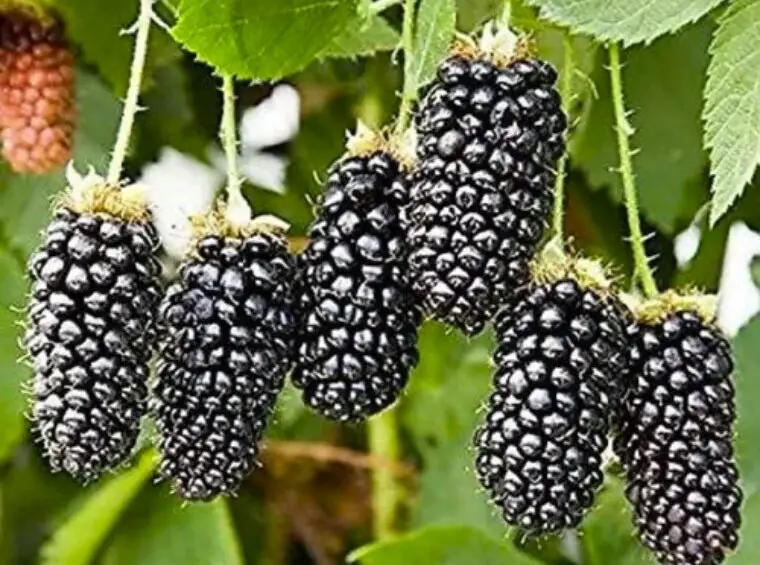
The mulberry tree is a miracle of nature, and its benefits are used almost everywhere today.
Due to its properties, it should not be missing in any home.
In our country, we find white, black and red mulberry trees.
Its fruits can easily be confused with raspberries.
Perhaps that is why it is often called the “raspberry of the trees”.
Mulberry caterpillars are especially fond of mulberry leaves.
For this reason, mulberry trees were planted next to roadsides and their fruits were dried, then ground into powder and used as an artificial sweetener.
Syrups, fruit wines and jams are also made from the mulberry tree.
Mulberry fruits contain many organic acids such as citric acid and malic acid.
It is rich in vitamins C, B, K, A, E, as well as potassium, magnesium, manganese and iron.
Some experts claim that not only the fruit, but also the bark and leaves of the mulberry tree are miraculous, preventing aging and helping with many diseases.
Black mulberry for infections This mulberry tree has a wide range of healing properties.
It is used to treat urinary tract infections or respiratory and throat diseases.
This mulberry tree is normally used to treat epilepsy, dizziness, insomnia or depression.
The juice helps treat coughs or problems with excess urine or sweating.
It also has a favorable effect on canker sores, effectively healing wounds on the gums.
Unripe fruits help treat diarrhea, while ripe fruits help treat constipation.
The white mulberry tree has applications in cosmetics.
This mulberry tree is mainly used in cosmetics.
White mulberry is present in many cosmetic products for whitening the skin and removing pigmentation spots, as it contains inhibitors that reduce melanin synthesis.
Many eye creams contain white mulberry to tone and cleanse the face.
Its effects are similar to those of black mulberry; It acts in cases of arthritis, body weakness, eye diseases and nervous system lability.
Mulberry bark for a healthier intestine The bark is an excellent remedy against intestinal parasites.
Helps treat the intestines and stomach.
It is also useful in cases of food poisoning, whether from alcohol or mushrooms.
A powder is produced from the bark that is used externally on wounds.
The fruits are generally harvested from June to August, and the leaves in spring.
The mulberry tree is advantageous because its fruits can be consumed both fresh and dried.
The mulberry tree has very versatile uses and its consumption can contribute positively to our health.
Mulberry leaf tea for diabetics The life of diabetics is certainly not easy. They have to monitor their body sugar levels daily.
In many difficulties associated with diabetes, mulberry leaf tea can help.
Place around 50 grams of mulberry leaves in half a liter of boiling water and leave to infuse for ten minutes.
Strain the tea and drink it throughout the day.
Syrup for sore throat and fever Place one kilogram of black mulberry berries in half a liter of water and add two teaspoons of apple cider vinegar.
Let the prepared syrup rest for 24 hours.
The next day, add a kilogram of brown sugar or another natural sweetener to the mixture.
Cook the syrup until it reaches the desired density.
Pour the prepared syrup into sterilized bottles and drink it several times a day diluted with water.
However, even with this miracle plant, it is important to remember that everything in excess is harmful.
Therefore, there is no need to overdo it with the mulberry tree. Excessive consumption can cause hallucinations or digestive problems.
And ultimately, it can do more harm than good. Give your body a touch of mulberry every day and your health will thank you.
My grandmother’s recipe for varicose veins
Grandma Moja never stopped praising the Alpine mulberry leaves.
She used this remedy exclusively for external applications, such as varicose veins, painful and swollen legs.
How did she prepare it?
To make it, you need fresh mulberry leaves, alcohol and a glass jar.
We maintain a proportion of 1:5, that is, for every 100 grams of leaves, 500 ml of brandy, or something similar, are needed.
Thanks to this proportion, you can easily prepare the amount of tincture you need.
Carefully wash the mulberry leaves and cut them into smaller pieces. Then, pour them into the bottle with alcohol, covering approximately 1 cm above the level of the leaves.
Close the container tightly, place it in a dark place and let the mixture macerate for two weeks (my aunt used to place it in the basement window, where it was dark). After this period
